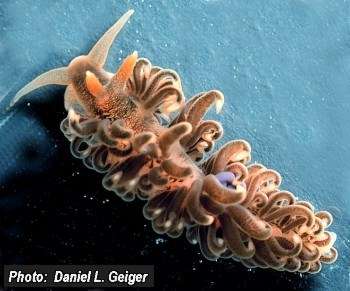
Spurilla neapolitana
(Delle Chiaje, 1823)
Order: NUDIBRANCHIA
Suborder: AEOLIDINA
Family: Aeolidiidae
DISTRIBUTION
Mediterranean, West Atlantic from Florida to Brazil. East Pacific (Baja California). See Spurilla sp. 1., a possible introduction to Japan.
PHOTO
Banyuls sur Mer, Mediterranean coast, France, 1990. PHOTOS: Daniel Geiger. Bottom two photos showing closeups of head and anterior body.
This large aeolid grows to at least 70mm in the Mediterranean. It ranges in colour from pink to orange, and the digestive gland ducts in the cerata range from grey to dark brown. Some specimens have patches of opaque white pigment on the body, while others have none. The rhinophores are lamellate, and the cerata quite flattened. In the photos below, fine branches of the digestive gland can be seen ramifying throughout the body wall, up into the rhinophores, and oral tentacles, and in the anterior part of the foot expose to sunlight. This clearly suggests that the animal is harbouring zooxanthellae it has obtained from the sea anemones that it has been feeding on. For further information on zooxanthellae symbiosis, see the pages on 'Solar-powered sea-slugs'. Also clearly visible is the opaque white defensive cnidosac at the tip of each ceras.
See also Spurilla creutzbergi for a discussion on white-spotted animals from the Caribbean.
-
Garcia-Gomez, J.C. & Cervera, J.L. (1985) Revision de Spurilla neapolitana Delle Chiaje, 1823 (Mollusca; Nudibranchiata). Journal of Molluscan Studies, 51: 138-156.
-
Marcus, Er. (1955). Opisthobranchia from Brazil. Boletim de la Faculdade de Filosofia Ciencias e Letras du Universidade de Sao Paulo. Zoologia, 20: 89-262.
-
Marcus, E. & Marcus, E. (1977) An annotated Checklist of the western Atlantic warm water opisthobranchs. Journal of Molluscan Studies, Supplement 4: 1-22.
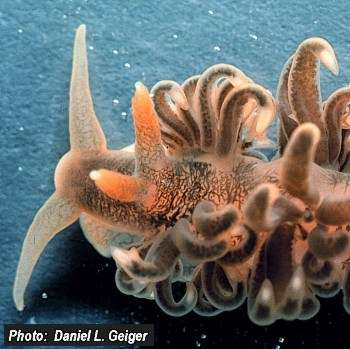
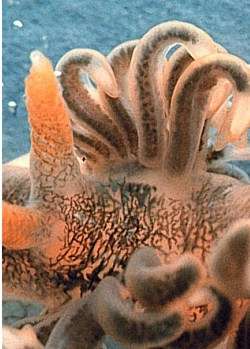
Rudman, W.B., 1999 (September 26) Spurilla neapolitana (Delle Chiaje, 1823). [In] Sea Slug Forum. Australian Museum, Sydney. Available from http://www.seaslugforum.net/find/spurneap
Related messages
Re: Sargassum sea slugs in Gulf of Mexico [2]
February 23, 2010
From: Kathe R. Jensen
Concerning message #23257:
Dear Bill,
Reading your answer to Denice's pictures reminded me of something we discussed in Bonn some years ago, namely Bergh's 1861 paper, which describes cnidocysts, or "urticating filaments" (nelde-fiim is an old Danish term, not in use presently). What Bergh actually describes here are the cnidocysts, not the slugs - and I think I said in 2006 that I would translate this paper so people could see that there were no description of nudibranch species (though some genera were briefly described in foot-notes). As for Kröyer describing a nudibranch, that also is not true. Bergh's foot-note on p. 322 states:
"Under the above name an aeolid is found in the Copenhagen zoological museum, which Kröyer has taken in the Sargasso Sea on 23 June 1841. - Ae. sargassi Phil. is Fiona atlantica Bgh., as I have pointed out previously (Contr. to a monogr. of the genus Fiona 1859, p.9)." - My translation.
So the specimen had been collected and labelled (and "named") by Kröyer, but there is no reference to any notes by Kröyer, and hence I think the author should still be Bergh. In 1861 there were no formal rules, and Bergh could "honour" Kröyer's naming the species even if Kröyer had contributed only the name. As for the "species description" my translation is:
"The elongate pear-shaped cnidosac contained rod-shaped urticating filaments of length 0.029-0.04 mm, which were most similar to the small elongate urticating filaments found in Ae. papillosa; more often a fine cottonwool-like ring appeared along the edges of the thread, which often hung out of the filament."
I don't know what you think, but I don't think this constitutes a valid description of a nudibranch. The species was properly described by Bergh in 1871:
- Beiträge zur Kenntniss der Mollusken des Sargassomeeres. Verhandlungen der könig-kaiserlischen zoologisch-botanischen Gesellschaft in Wien 21: 1273-1308, plates 11-13. Species description on pp. 1283-86, plate 13.
The 1861 paper unfortunately contains a long list of "new species descriptions" that are as comprehensive as above. I would like to know if the Nomenclature Commission finds such descriptions valid, because I don't see anything that would enable identification of the species.
Sorry for the long comment.
Best wishes,
Kathe
krjensen@snm.ku.dk
Jensen, K.R., 2010 (Feb 23) Re: Sargassum sea slugs in Gulf of Mexico [2]. [Message in] Sea Slug Forum. Australian Museum, Sydney. Available from http://www.seaslugforum.net/find/23268Dear Kathe,
No need to apologise, we need to be aware of these old nomenclatural messes. Bergh was particularly cavalier in his approach to nomenclatural rules and as this example shows l shouldn't have said anything until I had actually sighted the paper. What I was really drawing attention to was the need to cite the name as S. sargassicola (Kroyer in Bergh, 1861) rather than just as S. sargassicola (Kroyer, 1861) because there is no publication by Kroyer in 1861 to find!
Concerning whether Bergh could attribute the authorship of the name to Kroyer. I don't think there is anything wrong in principle with him doing that, but if there is no worthwhile description then you are right in bringing the validity of the name into question.
Thankfully there seems to be general acceptance that the name is a synonym of Spurilla neapolitana so we can just let 'sleeping dogs lie' - at least for now.
One other point to note. In a couple of bibliographies I note Bergh is attributed with an 1862 publication in the Quarterly Journal of Microscopical Science on 'urticating filaments'. On checking that out I see that the publication is in a section entitled TRANSLATIONS and is a summary/commentary in English of Bergh's 1861 paper. I can't find any indication to say who wrote this summary but clearly it shouldn't be cited as Bergh, 1862.
- Bergh, L. S. R. 1861. [for 1860]. Om Forekomsten af Neldfiim hos Mollusker. Videnskabelige Meddelelser fra den Naturhistoriske Forening, Kjöbenhavn, pp. 309-331, pl. 8.
- Anonymous, 1862. On the existence of urticating filaments in the Mollusca by Dr Bergh. [summary/translation of Bergh, L. S. R. 1861. [for 1860]. Om Forekomsten af Neldfiim hos Mollusker. Videnskabelige Meddelelser fra den Naturhistoriske Forening, Kjöbenhavn, pp. 309-331, pl. 8.] Quarterly Journal of Microscopical Science, new series 2: 274-277.
Best wishes,
Bill Rudman
Sargassum sea slugs in Gulf of Mexico [2]
February 22, 2010
From: Denice Drass
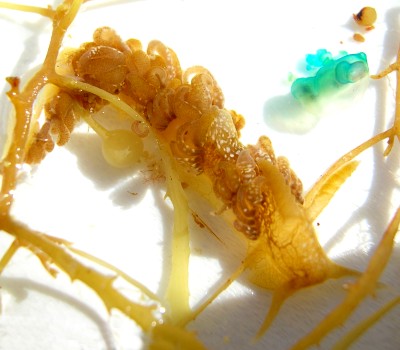
Dear Bill,
These specimens were collected in Sargassum with a neuston net offshore of Louisiana in the Gulf of Mexico in February of 2008 at around 5 am. I have wondered about how different they are and was given your website to send the pictures to. I did not measure the specimens, however the diameter of the lid that the specimens are floating in is 90 mm.
Locality: 28.00 N, 90.00 W, offshore of Lousiana, Gulf of Mexico, 09 February 2008, neuston. Photographer: Denice Drass.
Denice Drass
Denice.Drass@noaa.gov
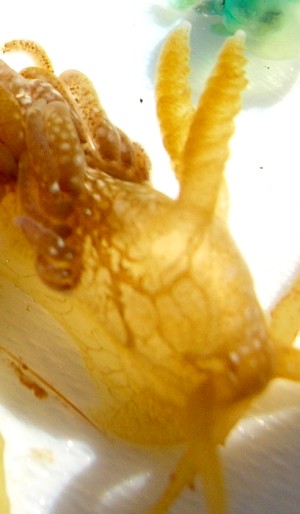

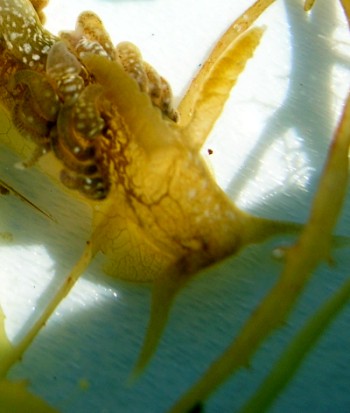
Dear Denice,
I have separated this species out from those in your earlier message [#23255]
This is an interesting aeolid nudibranch, belonging to a group I have called solar-powered because they have adapted their digestive system and general anatomy to enable them to keep microscopic algae alive in their bodies. Have a look at the Solar-powered Fact Sheet for more information. The brown specks in the skin and the branching brown veins through the body wall are adaptations of the gut containing algae. Your species was named Facelina sargassicola Kroyer [in Bergh, 1861:322] and the name was later changed to Spurilla sargassicola. The literature is confusing because it is sometimes referred to as Spurilla sargassicola (Bergh, 1861) and sometimes as Spurilla sargassicola (Kroyer, 1861). As Bergh nominated Kroy as the author of the name in Bergh's 1861 publication the correct way to cite the name is Spurilla sargassicola (Kroyer in Bergh, 1861).
To confuse the situation, it is generally considered that Spurilla sargassicola is the same as Spurilla neapolitana. If this is so what about the different lifestyles? While S. sargassicola is found on floating Sargassum, S. neapolitana is found crawling on hard substrates. Species of Spurilla feed on sea anemones which they find on rocky shores and also brown algae. If S. sargassicola is the same as S. neapolitana it would suggest that its lifestyle on floating Sargassum could arise at the larval stage simply by its free-swimming pelagic larvae settling out on floating Sargassum rather than on the sea floor.
- BERGH, L. S. R. 1861. [for 1860]. Om Forekomsten af Neldfiim hos Mollusker. Videnskabelige Meddelelser fra den Naturhistoriske Forening, Kjöbenhavn, pp. 309-331, pl. 8.
Best wishes,
Bill Rudman
Feeding Spurilla neapolitana from Florida
July 25, 2008
From: Linda Ianniello
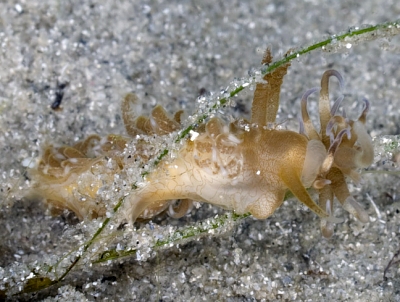
Dr. Bill,
Attached are three images of what I believe is a Spurilla neapolitana feeding - progressively eating an anemone - the photos are arranged in order. The little anemones are quite abundant now so he-she has plenty to feed on.
Hopefully an addition to your collection of "nudibranchs doing something".
Locality: Lake Worth Lagoon, 10 feet, Florida, USA, Atlantic, 19 July 2008, Intracoastal, tidal. Length: approximately 1.5 inches. Photographer: Linda Ianniello.
As always, thank you for your great work with this forum!
Linda Ianniello
lindai1@bellsouth.net
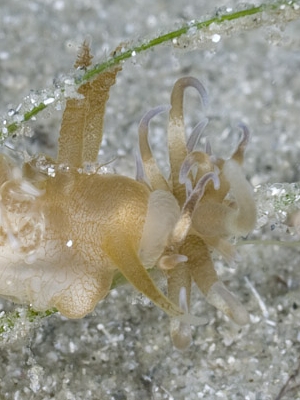
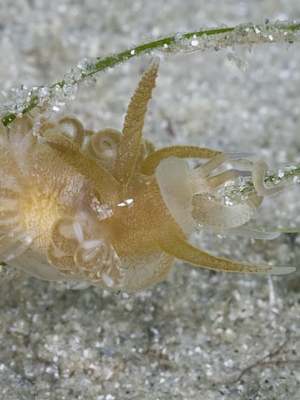
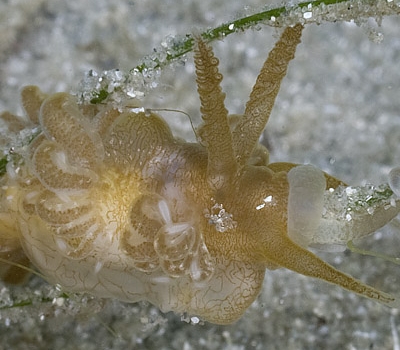
Dear Linda,
Thanks very much for the photos and the feeding record. From your photos it looks like the oral tentacles are used a bit like 'hands' wrapping around the anemone to prevent it from escaping. That is certainly what our southern Spurilla, Spurilla australis does. We can easily see in your photos the brown vein-like pattern which is spread throughout the foot and the body wall. This tells us that this is indeed a 'solar-powered' slug, the small veins harbouring brown zooxanthellae from the sea anemones that Spurilla is feeding on.
Best wishes,
Bill Rudman
Mystery from the Everglades, Florida, USA
July 18, 2008
From: Sophia Floyd

Hello Bill,
I very much enjoyed your Sea Slug Forum website. We found this
nudibranch in the Everglades [Florida, USA] last year and have been unable to identify it.
It is beautiful in its form and it's loops are apparently unusual. It is
about 6 cm long. We photographed it and let it go. Do you have any
information on it? My 10 year daughter found it. She is passionate about
insects.
Sophia Floyd
Denver, Colorado, USA
david.floyd@comcast.net

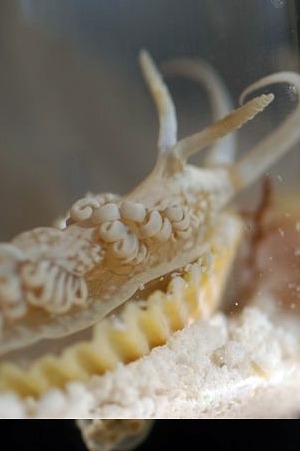
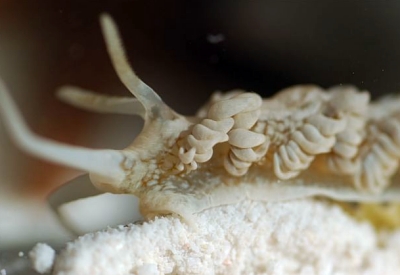
Dear Sophia,
This is an aeolid nudibranch, which are commonly known as 'sea slugs'. It is Spurilla neapolitana which was first described across the Atlantic, in the Mediterranean. As you will see from earlier messages on the species it is quite variable in colour, which may be a result of the different coloured sea anemones it feeds on. The 'loops' you mention are unique structures called cerata, found only in aeolids. They contain branches of the animal's digestive system, and at their tips they have a special sac [cnidosac] which contains stinging cells [nematocysts] which they steal from the sea anemones they feed on. In your photos the cerata are lying 'at rest' but when disturbed the animal can straighten them - with the stinging cells at the tip - as a protective measure.
Best wishes,
Bill Rudman
Spurilla neapolitana predator
March 31, 2008
From: Joao Pedro Silva
Dear Bill,
Last saturday me and my wife went for a nocturnal dive in Baleal. As we don't have much experience on night dives, I decided it would be better to leave the photo gear at home. Of course, animals detect the absence of such equipment and use these opportunities to show the least seen behaviors.
Before this dive I had only seen Spurilla neapolitana in the intertidal zone. They can be quite abundant in August in a particular area in Baleal and are easily found in rock pools during the low tide. This time I found two. One was crawling over a well known wreck at 8 m depth. The other was found at the end of the dive, near the beach, just 4 m deep... trapped by the chelipeds of a crab, Necora puber. No photos, I'm afraid, but my wife can provide a sworn statement.
Is there any previous record of Spurilla neapolitana being being preyed by crabs, like Necora puber?
Locality: Baleal, between 3 and 8 meters, Portugal, North Atlantic, 03 November 2007, wreckl. Length: 3cm
Best regards,
Joao Pedro
jpsilva@uwphotographer.net
Silva, J. P., 2008 (Mar 31) Spurilla neapolitana predator. [Message in] Sea Slug Forum. Australian Museum, Sydney. Available from http://www.seaslugforum.net/find/21086Dear Joao Pedro,
Thanks for the interesting observation which is a nice addition to the nudibranch predation page. One of the reasons for starting the page was to accumulate this sort of information which is usually not published. If we looked through publications on the feeding behaviour of crabs we might find some information on any nudibranchs being eaten but it is unlikely. So trying to work back from the potential 'victim' would be impossibly time-consuming. So I can't say if anyone has recorded anything eating Spurilla neapolitana, but hopefully if anyone has any information they will let us know.
Best wishes,
Bill Rudman
Spurilla neapolitana in Brazil
January 23, 2006
From: Daniel Pimpão
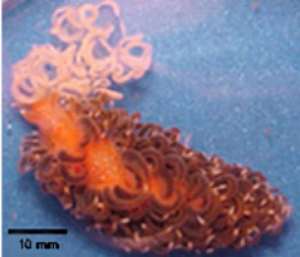
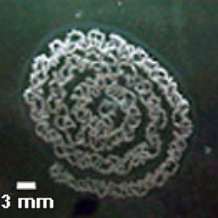
Concerning message #7102:
Dear Bill,
Some years ago you helped me with paper information. I am not working with Nudibranchia anymore, unfortunately, but I would like to send you two Spurilla neapolitana pictures (one spawn) from Brazil. I would like to have more but I do not. Nevertheless I think Carlo Magenta has more information about Spurilla in Brazil.
Locality: Santa Catarina Island, Santa Catarina, Brazil. Atlantic Ocean
Best wishes,
Daniel.
danielpimpao@yahoo.com.br
Pimpão, D.M., 2006 (Jan 23) Spurilla neapolitana in Brazil. [Message in] Sea Slug Forum. Australian Museum, Sydney. Available from http://www.seaslugforum.net/find/15622Dear Pimpão,
Thanks for the photos. The egg ribbon certainly is of the same type as that found in Mediterranean animals [see message #11742]
Best wishes,
Bill Rudman
Mystery from St. Vincent Is, Caribbean [1]
November 3, 2005
From: Les Wilk
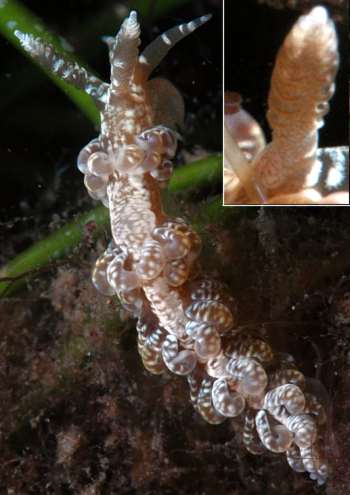
Hi Bill;
Drawing a blank on this one. Any ideas?
Locality: west coast St. Vincent Is., Caribbean. Depth: 15 feet. Length: 1 inch. July 2005 grassy bottom. Photographer: Keri Wilk
Les Wilk
wilk@reefnet.ca
Wilk, L., 2005 (Nov 3) Mystery from St. Vincent Is, Caribbean [1]. [Message in] Sea Slug Forum. Australian Museum, Sydney. Available from http://www.seaslugforum.net/find/15088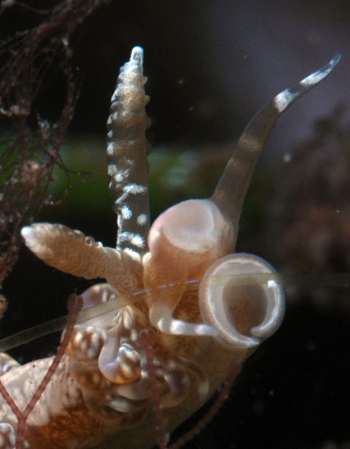
Dear Les,
From its general shape and colour I would guess this is a member of the Aeolidiidae, and is almost ceratinly one of the animals I have been calling Spurilla neapolitana from the tropical western Atlantic. There seem to be a couple of similar species confused on the page, one with double rows of cerata like yours, and one with more cerata. I can't say I am very confident that either are S. neapolitana. It is the animal Colin Redfern calls Spurilla sp. inBahamian Sea Shells . If you look at the inset of the magnified rhinophore you will see a brown network on the white. I am sure this is branches of the digestive gland ramifying inot the skin of the body wall, which is a sure sign of a solar powered species. Not that that identifies it, but its a nice bit of background information.
For convenience, I am keeping all these Caribbean animals together on the S. neapolitana page.
Best wishes,
Bill Rudman
Re: Spurilla neapolitana from Gulf of Mexico [7]
September 10, 2005
From: Brian Plankis
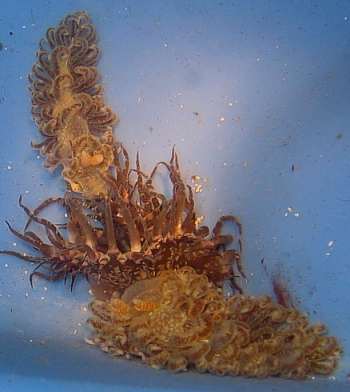
Bill,
I have been observing the adults and they now eat three separate species of anemone. The tulips pictured earlier and two different Aiptasia species. In all cases the adults will move until they can begin feeding on the foot of the anemone, always finishing with the oral disk. I have attached a picture of them eating the latest aiptasia species tested. They never seem to detach from the anemone once feeding starts. A large tulip anemone takes 2-4 hours to eat, both aiptasia species take 45mins to 1.5 hours to eat.
I also have begun filtering the water used for hatching the eggs and when I was transfering the latest batch of eggs over, I accidentially induced a hatching. I've attached a picture at 4x magnification. I'm slightly optomistic as the newly hatched babies were visible to the naked eye and I have smaller aiptasia for them to feed on now. At least I know the eggs are viable now as they were moving around in the water.
I'm still working on getting a picture of the head and neck to see if they are storing the microscopic plants, but no good pictures yet.
Brian
garagebrian@yahoo.com
Plankis, B.J., 2005 (Sep 10) Re: Spurilla neapolitana from Gulf of Mexico [7]. [Message in] Sea Slug Forum. Australian Museum, Sydney. Available from http://www.seaslugforum.net/find/14725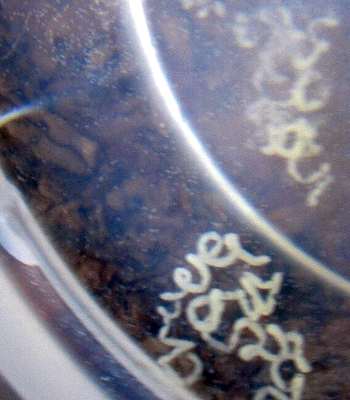
Thanks Brian,
I wish you the best of luck with the veliger larvae
Bill Rudman
Re: Spurilla neapolitana from Gulf of Mexico [6]
September 9, 2005
From: Brian Plankis
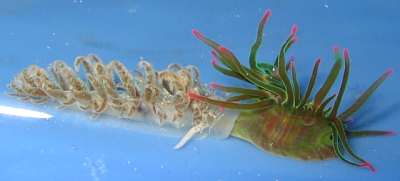
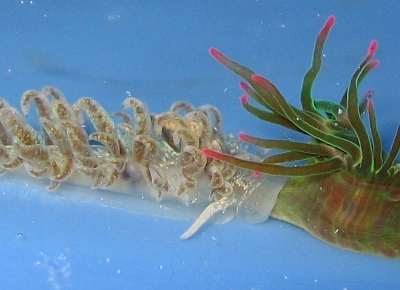
Bill,
I'm more than happy to share the feeding observations. Here is what I have observed so far. The adults are kept in a bucket with no water movement; I aerate it manually once a day.
1. The adults tend to stay stationary much of the time. They occasionally move around at night, but usually they are just sitting in one location. This changes when anemones are added to the bucket, typically within 10-15 minutes of the anemones being added they will begin to hunt for them in a rather deliberate pattern.
2. The anemone in my most recent picture had just been added to the bucket and did not have time to firmly attach to the side before the meal began. But typically the adults will seek out the anemone and once found the adults will seek out the foot of the anemone and begin tugging on the foot until a portion of it detaches from the surface. I've attached two more pictures to show this.
3. They do not appear to take bites; once feeding has started the adults have never disengaged from the anemones. They will slowly eat at the foot and side of the anemone until they reach the oral disc and typically eat that last. It takes them about 2-4 hours to eat one depending on the size of the anemone.
4. The smaller of my adults can eat anemones about twice its size in one meal, it is very swollen after one of those meals. Both animals are displaying a prominent hump on the back after a large meal.
I do agree with your other message (#14667) that this looks a lot more like Spurilla neapolitana than Aeolidiella stephanieae. I have had 18 egg masses so far and only one was basically linear, the remainder were variously shaped spirals. My adults look identical to the nudibranch in Ami Schlesinger's photo [#11742 ]. The egg mass in her photos are larger than mine, but same zig zag pattern and apparent size of the eggs.
I will be trying to feed Aiptasia species of anemones soon and will see if the feeding pattern is any different.
Brian
garagebrian@yahoo.com
Plankis, B., 2005 (Sep 9) Re: Spurilla neapolitana from Gulf of Mexico [6]. [Message in] Sea Slug Forum. Australian Museum, Sydney. Available from http://www.seaslugforum.net/find/14671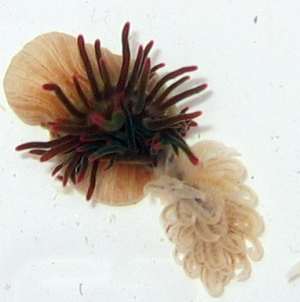
Dear Brian,
Thanks for the observations. Hopefully it will inspire others to look in depth at a single species.
Best wishes,
Bill Rudman
Re: Spurilla neapolitana from Gulf of Mexico [5]
August 30, 2005
From: Brian Plankis
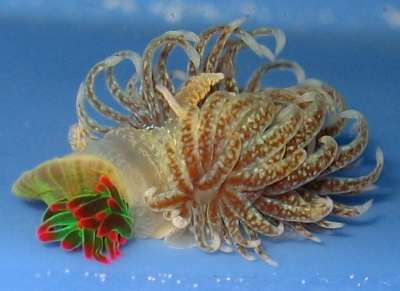
Bill,
Re message #14625: No babies showing up yet, but it is still early. I just wanted to share what I thought was this stunning image of my larger nudibranch feasting on an anemone. Both adults appear content and are eating 1 anemone every 3 days and laying eggs every 1-2 days.
Brian
garagebrian@yahoo.com
Plankis, B., 2005 (Aug 30) Re: Spurilla neapolitana from Gulf of Mexico [5]. [Message in] Sea Slug Forum. Australian Museum, Sydney. Available from http://www.seaslugforum.net/find/14649Thanks Brian,
Can you give us a description on how it eats the anemones? or does that depend on size? In this photo it looks like it loosens the anemone's grip on the substrate and eats it whole. It certainly doesn't seem to be taken little bites.
Best wishes,
Bill Rudman
Identity of Brian Plankis's anemone-feeding aeolid
August 30, 2005
From: Bill Rudman
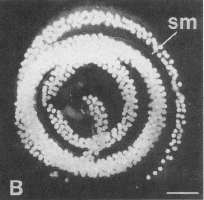
I initially identified Brian Plankis's anemone-feeding aeolid [message #14503] as Spurilla neapolitana but was slightly sidetracked from thinking further about its indentity by his interesting aquarium observations on its biology. I was begiining to think it was the species recently described as Aeolidiella stephanieae but it certainly doesn't have the white pigmentation on the back as in that species, and instead has the many white patches found in S. neapolitana from the other side of the Atlantic. Further confirmation can be seen in the shape of the egg ribbons. Brian's photos [#14595] show the egg ribbon to be a zig-zag string which, in an earlier photo of his [#14532] forms a spiral. This is identical to the shape shown in Ami Schlesinger's photo [#11742 ] of specimens from the Mediterranean coast of Israel.
Luckily Carroll & Kempf (1990) have a photo of the egg ribbon of Aeolidiella stephanieae [as Berghia verrucicornis: Fig, 2B] which I have copied here for comparison. It is clearly quite different with the egg string forming a simple spiral. I think this is good evidence to support my initial identification of Brian's animals as Spurilla neapolitana and to show that is has an amphiatlantic distribution, and apparently occurs sympatrically with Aeolidiella stephanieae, at least in the Gulf of Mexico.
- Carroll, D.J. and S.C. Kempf. (1990). Laboratory culture of the aeolid nudibranch Berghia verrucicornis (Mollusca, Opisthobranchia): Some aspects of its development and life history. Biological Bulletin, 179: 243-253.
Best wishes
Bill Rudman
Spurilla neapolitana from Saint-Tropez
August 26, 2005
From: Benjamin David-Testanière
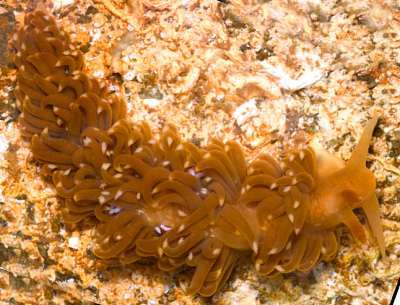
Hi,
First sorry for my English ... I'm french photographer who is photographing some sea animals through the water. Recently I have had on my website http://www.bdt-photos.com a sea slug picture.
Locality: Saint-Tropez, la pointe de Capon, France ( département du Var, 83 ) Mditerranean sea. Depth: 20 centimètres. 03 April 2005. Photographer: Benjamin David-Testanière
There was three specimens under a stone. I have put one of them on the stone for the picture.
Can you help me to identify it ?
Thanks to all !
Benjamin David-Testanière
bdt@bdt-photos.com
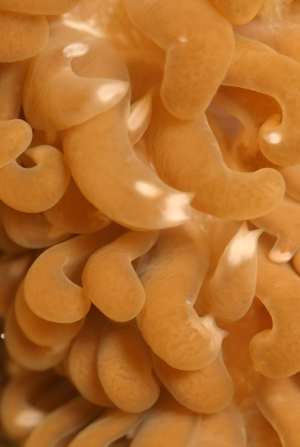
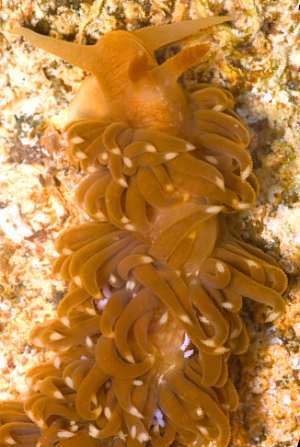
Dear Benjamin,
This is Spurilla neapolitana. I see from your website you are partial to the beauty of orchids. Spurilla neapolitana is not the most beautiful of nudibranchs, but it has a fascinating biology. It is one of a group that I call 'solar-powered' because they keep small plants alive in their bodies and utilise the sugars the plants produce from photosynthesis. As the plants need sunlight to photosynthesise, Spurilla has developed a network of thin tubes throughout its skin for the plants to live in. You can see them as dark veins on the head and 'neck' in the lower right close-up. See also an earlier message [#7886] which shows these veins more clearly.
Another interesting feature in the lower right your photo are the purplish sausage-shaped objects on its back. They are the egg sacs of a copepod crustacean which seems to occur not uncommonly on this nudibranch. See also the Fact Sheet on symbiosis and an earlier message from Erwin Koehler [#1428] showing an animal heavily infested with these copepods.
In the lower left close-up, the white tips of the of the cerata can be seen in detail. We can see that the white is an elongate sac inside the ceratal tip which we call a cnidosac, because it stores stinging cells [cnidae, nematocysts] from the sea anemones it feeds on. Have a look at the relevant Fact Sheets for more information. Usually there is just one cnidosac at the tip of each ceras, but your close-up seems to have targetted an animal in which there are two cnidsacs and a bifid tip to most of the cerata.
Best wishes,
Bill Rudman
Re: Spurilla neapolitana from Gulf of Mexico [4]
August 25, 2005
From: Brian Plankis
Bill,
Thanks for the reply about the possible non-feeding stage [message #14595]. I don't give up hope easily so I'm going to be trying to raise these for at least a few months. I read Dr Calfo's article on raising of Berghia (now Aeolidiella stephanieae) and did not see any info on when it would be safe to do water changes on the newly hatched eggs buckets.
Will the newly hatched larvae settle to the bottom and side of the bucket within a few days or do I need to wait longer to do a water change?
Both of my adults are now laying eggs with the smaller nudibranch producing an egg mass 1/3 the size of the larger nudibranch. I'm up to a total of 10 egg masses now of which 5 have hatched.
I keep live phtyo for my main tank, would some of this aid the newly hatched nudibranches if they actually do feed in the planktonic stage, or do I need a specific phyto species?
B.
garagebrian@yahoo.com
Plankis, B., 2005 (Aug 25) Re: Spurilla neapolitana from Gulf of Mexico [4]. [Message in] Sea Slug Forum. Australian Museum, Sydney. Available from http://www.seaslugforum.net/find/14625Dear Brian,
I don't know Dr Calfo's publication but the two on the 'Berghia verrucicornis' in aquaria page both give fairly full directions which should work if your animal has a non-feeding veliger stage. If your animal has an algal feeding stage then it is all much more complicated. There is a good article on culturing larval sea hares [see message #3191] which discusses suitable phytoplankton but its possible what you have might work.
I'm afraid I have no personal experience at keeping planktotrophic larvae alive - I us to give up when they got stuck in the surface film on day 1 or 2 so all I can really do is hope your animals have non-feeding larvae, and if not, wish you luck.
Best wishes,
Bill Rudman
Re: Spurilla neapolitana from Gulf of Mexico [3]
August 20, 2005
From: Brian Plankis
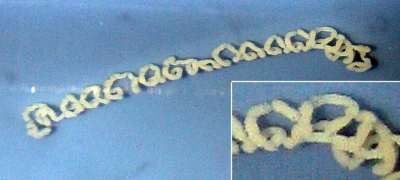

Dear Bill and Forum readers,
I wanted to provide a brief update to my tentatively ID'd Spurilla neapolitana [see message #14532]. They have laid a total of 5 egg masses but I believe the first one was out of water for some time since I didn't notice it and it has not hatched. Egg masses 2-4 have hatched but I do not see any babies yet. Egg mass 5 was laid last night in the new blue bucket that provided a better photo opportunity.
Attached are pictures of egg mass number 5. Adults appear healthy and mate every two to three days. It seems they need one anemone every 3-4 days to be interested in egg laying. The second egg mass is slightly overexposed to bring out a little more detail. The eggs appear quite small so I'm beginning to think the breeding efforts will not produce young.
I am putting plastic plates into the adult's bucket in hopes they will lay some eggs on there and I can remove one mass for better photos.
Brian
garagebrian@yahoo.com
Plankis, B., 2005 (Aug 20) Re: Spurilla neapolitana from Gulf of Mexico [3]. [Message in] Sea Slug Forum. Australian Museum, Sydney. Available from http://www.seaslugforum.net/find/14595Dear Brian,
Thanks for keeping us informed of progress. I can see the eggs. Don't give up hope. There is always a chance they will develop into lecithotrophic larvae. This is a type of larvae which has a short free swimming veliger stage, but it does not feed in the plankton. Some coral eating aeolids have this form of development, in some case spending less than an hour swimming. These are easily bred in the aquarium.
Best wishes,
Bill Rudman
Re: Spurilla neapolitana from Gulf of Mexico [2]
August 11, 2005
From: Brian Plankis
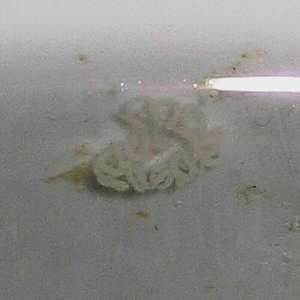
Bill,
Thanks for the reply [#14521 ]. First I'll address your questions, then a brief update:
"Am I right in thinking I can see both animals in your photo. I think I can see two extra rhinophores to the left of the obvious ones. If this is the way they are nestling it isn't mating. Their reproductive openings are on the right side of the body, just behind the rhinophores, so they need to have their right sides together."
Yes you are correct you see both of them, however the picture does show their right sides together. My smaller nudibranch is in the foreground of the picture and its head is to the left, making its left side face the viewer. The considerably larger nudibranch has its head and the length of the body aimed directly at the camera. So the rhinophores of the smaller nudibranch are on the right side of the larger one and visa versa.
"If they do lay eggs I would appreciate a photo if possible - but they probably will lay them in the most difficult place in your aquarium for a photo."
Well, Bill, you were right! They layed eggs in one of the most difficult spots to photograph, right below the water line. I took well over two dozen pictures and the attached one is the best I can do. Examination under a magnifying glass revealed more of a U shape than a spiral. Hopefully the next egg mass will be in a better place to photograph, they ate two more anemones last night and were snuggling again this morning!
More later,
Brian:
garagebrian@yahoo.com
Plankis, B., 2005 (Aug 11) Re: Spurilla neapolitana from Gulf of Mexico [2]. [Message in] Sea Slug Forum. Australian Museum, Sydney. Available from http://www.seaslugforum.net/find/14532Dear Brian,
Thanks for the update. The egg ribbon seems to be in a tight wave shape which is itself arranges in a coil - or circle. This is not unusual in some aeolids - including the related Aeolidia papillosa. Why I am interested is that some aeolidiids have an abbreviated larval stage in their development, and may miss out the free swiming larval veliger stage. If that was the case with your animals you might have a chance of breeding a second generation. It couls also be a way of distinguishing different species. I can't see enough from you photo to be sure, but the eggs look quite small suggesting it has a veliger stage. Anyway, I look forward to future reports.
Best wishes,
Bill Rudman
Re: Spurilla neapolitana from Gulf of Mexico [1]
August 9, 2005
From: Brian Plankis
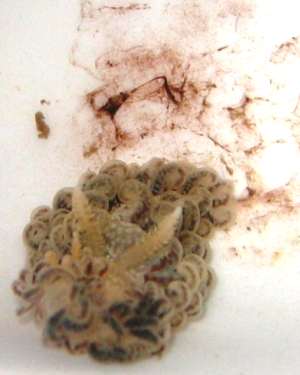
Bill,
Thanks for the response [#14503] and I am going to do a variety of experiments on what foods it will eat and the resulting color changes. Up next is an Aiptasia species.
The last two days my nudibranchs have been inseparable, I have frequently seen them together with their heads tucked into just behind the rhinophores of the other nudibranch. Would this be mating activity?
I also have found red masses near the animals every morning. According to what I have read so far this looks more like waste than eggs, would you concur? Here is a picture:
I also included this picture as it gives a better picture of the rhinophores detail which is quite jagged.
Thanks,
Brian
garagebrian@yahoo.com
Plankis, B., 2005 (Aug 9) Re: Spurilla neapolitana from Gulf of Mexico [1]. [Message in] Sea Slug Forum. Australian Museum, Sydney. Available from http://www.seaslugforum.net/find/14521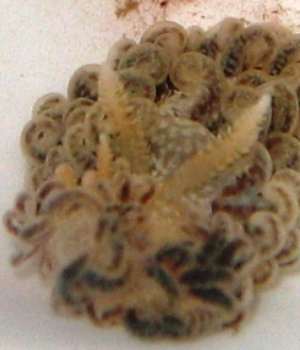
Dear Brian,
Am I right in thinkin I can see both animals in your photo. I think I can see two extra rhinophores to the left of the obvious ones. If this is the way they are nestling it isn't mating. Their reproductive openings are on the right side of the body, just behind the rhinophores, so they need to have their right sides together. As you say the red mucousy mess in your photo is not eggs. Sometimes animals extrude such material from the reproductive system, but it could just be mucous that is secreted from the foot overnight. If the animals nestle together and stay in one spot overnight - 'sleeping'?- then this could just be an accumulation of the mucus they normally produce from glands in their foot as they crawl along.
I look forward to hearing about your experiments. It may take a few days or weeks for any colour chnage to occur so don't change their food too quickly. If they do lay eggs I would appreciate a photo if possible - but they probably will lay them in the most difficult place in your aquarium for a photo.
Best wishes,
Bill Rudman
Aeolidiella chromosoma or S. neapolitana
August 8, 2005
From: Nestor E. Ardila E.
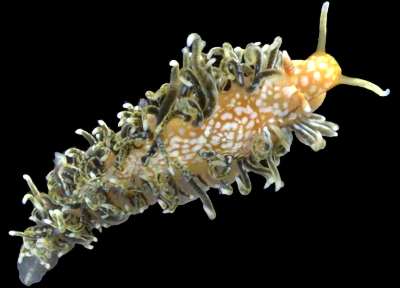
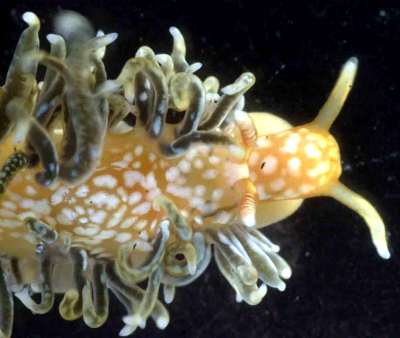
Dear Bil,
I send a picture of two animals collected in Santa Marta area Colombia.
I feel that this 'morph' looks very like the animal from Japan which has been identified as Spurilla or better Aeolidiella chromosoma. Although this species A. chromosoma (Cockerell & Eliot, 1905) is originally described from California.
I haven't dissected this animals yet, but I think so is necessary a good review of this species, in order to determine if this species have amphiamerican distribution or circumtropical...or if chromosoma is a synomym of S. neapolitana....?????
Locality: Neguanje Bay, Santa Marta, COLOMBIA, Caribbean Sea. Depth: 5 m. Length: 25 mm. artificial collectors of bivalves. Photographer: Nestor Ardila
Nestor Ardila
neardila@yahoo.com
Ardila, N. E., 2005 (Aug 8) Aeolidiella chromosoma or S. neapolitana. [Message in] Sea Slug Forum. Australian Museum, Sydney. Available from http://www.seaslugforum.net/find/14490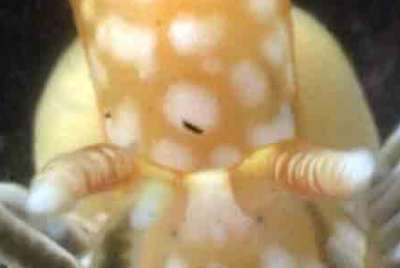
Dear Nestor,
Thanks for the photos and I agree with the many question marks. Your animal certainly looks like some of the Japanese animals - but also like others we have on the Forum from the Caribbean. Your animal doesn't seem to show any signs of digestive gland branching on the head and skin outside the cerata which is what you would expect in S. neapolitana. I agrees one work needs to be done on these animals but it needs to be comparative work on all the 'forms' from both oceans. I'll put your animal on the Spurilla neapolitana page - but not with any great conviction
Best wishes,
Bill Rudman
Spurilla neapolitana from Gulf of Mexico
August 8, 2005
From: Brian Plankis
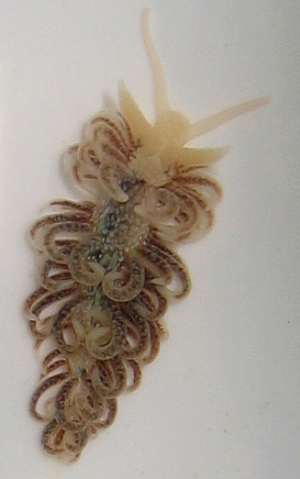
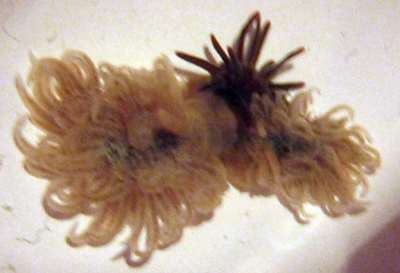
Dear Sea Slug forum,
I recently purchased some Florida aquacultured live rock and I received these two nudibranches on the rock as hitchhikers. I'm relatively new to the reef hobby and completely new to nudibranches, can anyone narrow down what species this might be? Is there something else you need a picture of to ID?
Greenbean on reefcentral thought they might be Spurilla neapolitana. To test this I decided to feed it what some people call "tulip" anemones, two of the pictures show them eating them quite readily.
The location below is an estimate as Richard from Tampa Bay Saltwater can give you the exact details. Now that I know it has a food source for a while, what else should I supply to keep them alive? Temperature, salinity and other water parameters, aeration?
Locality: 20 miles NW of Tampa, Florida, USA Gulf of Mexico. Depth: 30-40 feet. Length: 1 inch. 05 August 2005. Photographer: Brian Plankis
Thanks,
Brian
garagebrian@yahoo.com
Plankis, B., 2005 (Aug 8) Spurilla neapolitana from Gulf of Mexico . [Message in] Sea Slug Forum. Australian Museum, Sydney. Available from http://www.seaslugforum.net/find/14503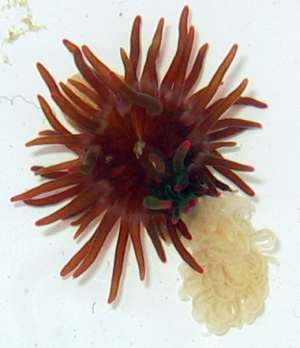
Dear Brian,
Your message is a remarkable coincidence as I am posting another message from Colombia today [#14490] about a similar animal, and recently another from Portugal [#14467]. As you will see there is some debate about the true identity of this animal, so your photos are useful in that discussion..
You shouldn't have many problems keeping it alive in an aquaria. As long as you keep the water healthy for other marine life there si no reason why it shouldn't thrive on anemones. If you want to try a little experiment it would be interesting to know how much its body colour is dependent on the colour of the anemones it eats. You could feed it just on green anemones for a while and then swap to red or orange or brown anemones to see what happens. If you decide to try please take some photos to keep a record of what happens.
Best wishes,
Bill Rudman
Spurilla neapolitana from Portugal
August 5, 2005
From: Ana Maria Rodrigues
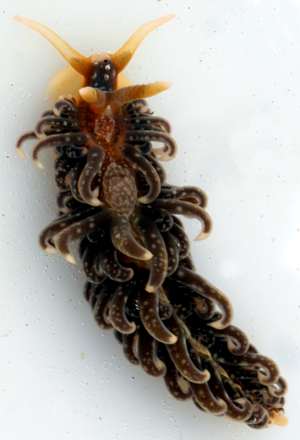
Dear Bill,
To accompany my message on Hypselodoris villafranca [#14470], here is one from Portugal that I can't identify. Using the sea slug forum it is most similar perhaps to Aeolidiella alderi (????). So I would like to ask for your help
Locality: Viana do Castelo (Praia do Norte), Portugal. tide pools - 1 m (intertidal). Length: 3 cm. 08 May 2005. Photographer: Victor Quintino
Ana Rodrigues
anarod@bio.ua.pt
Rodrigues, A. M., 2005 (Aug 5) Spurilla neapolitana from Portugal. [Message in] Sea Slug Forum. Australian Museum, Sydney. Available from http://www.seaslugforum.net/find/14467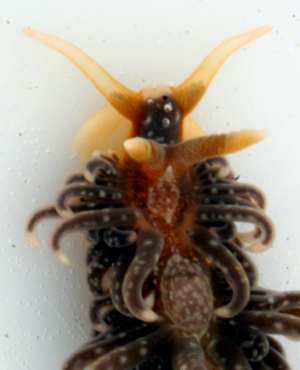
Dear Ana,
This is a nice addition to the Forum. It is Spurilla neapolitana, an aeolid in the same family as Aeolidiella alderi, but one with a particularly interesting way of life. It is one of the group of species which I have described as solar-powered because they 'farm' microscopic plants [zooxanthellae] in their tissues. Have a look at the various pages on the Forum describing this symbiosis. Please thank Victor for this nice photo. I have very few photos of this species from the European side of the Atlantic so this is a valuable addition. In the close-up alongside, the dark shadow in the base of the head tentacles [oral tentacles and rhinophores] are branches of the digestive gland containing zooxanthellae. In 'solar-powered' species the digestive gland branches to all parts of the body in contact with sunlight, to maximise the area available for photosynthesis. The large swelling in the middle of the back - near the bottom of the photo - is the pericardial swelling which contains the heart. If you look carefully in most aeolids you can see the heart pumping away.
Best wishes,
Bill Rudman
Spurilla neapolitana from Mexico
June 1, 2005
From: Juan José Alfaro M
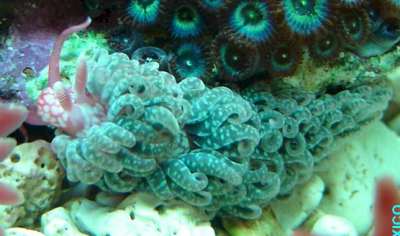
Dear Friends
Greetings from México City, México :)
My name is Juan José Alfaro and I am the owner of www.alfaquarium.com. I have a Forum in which one of my friends submitted a picture asking what was it [Photographer: Manavion]. I believe it is a Nudibranch but I would like to know a little more about it so I can tell him, as you will see in the picture he has a reef aquarium with corals, and I believe that some of this beautiful animals are corallivores.
Any info that you may give me it will be submitted in Alfaquariums Forum giving all the credits to this amazing organization.
Best Regards
Juan José
juanjose@alfaquarium.com
Alfaro, J.J., 2005 (Jun 1) Spurilla neapolitana from Mexico. [Message in] Sea Slug Forum. Australian Museum, Sydney. Available from http://www.seaslugforum.net/find/13898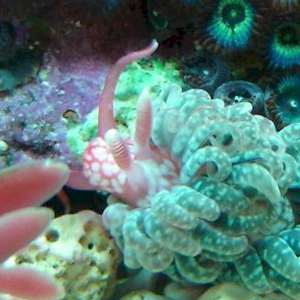
Dear Juan José,
This is indeed a nudibranch. It is an aeolid species which has been tentatively identified with the Mediterranean species Spurilla neapolitana, but I think more work is needed before we can confirm that. This 'form' has been reported from the Caribbean and down to central Brazil. Species of Spurilla feed on sea anemones rather than hard corals, so although the corals in the aquarium may be safe I suspect sea anemones might be in danger. However if you find it is feeding on a common sea anemone it might be better to replace the anemones every now and again rather than remove the beautiful nudibranch.
Best wishes,
Bill Rudman
Re: Phestilla melanobrachia from the Solomon Ids
July 22, 2004
From: Andrej Jaklin
Dear Bill,
Regarding the question about dependence of slug - food colour [m12694], here is my observation from many years ago:
Spurilla neapolitana is normally brown, since it feeds on Anemonia spp., which is also brown; after keeping a couple of Spurilla in a jar with red Actinia equina, the slugs turned to the "reddish form"! Of course, Actinia was half eaten within two or three days, I can't remember any more. If nothing else, it's a nice hint to further observers.
Best regards,
AJ
jaklin@cim.irb.hr
Jaklin, A., 2004 (Jul 22) Re: Phestilla melanobrachia from the Solomon Ids. [Message in] Sea Slug Forum. Australian Museum, Sydney. Available from http://www.seaslugforum.net/find/12699Thanks Andrej,
Since you have seen reddish Spurilla from the Mediterranean, I would be interested in your opinion in the reddish animal in Colin Redfern's message [m11310] from the Bahamas, and Carlo Magenta's very red animal from Brazil [m371]. I wondered at the time whether the colour was food related.
Cheers
Bill Rudman
Anemone-eating slug from Israel
December 24, 2003
From: Ami Schlesinger
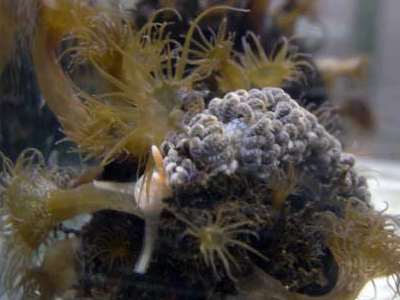
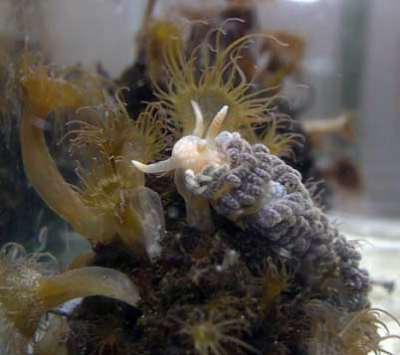
Dear Bill,
I found this slug 1 mile off the Israeli Medditerranean coast, on a rope covered with Anemones. It eats Anemones and lays white ribbon like egg cases. I am interested in its taxonomical classification. Perhaps it is an Aeolide?
Thanks in advance,
Respectfully,
Ami Schlesinger
amischle@post.tau.ac.il
Schlesinger, A., 2003 (Dec 24) Anemone-eating slug from Israel. [Message in] Sea Slug Forum. Australian Museum, Sydney. Available from http://www.seaslugforum.net/find/11742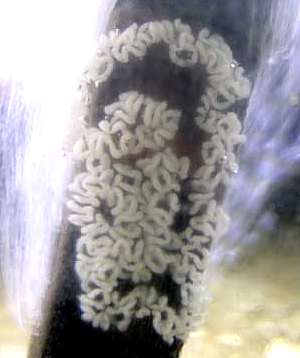
Dear Ami,
As you suspected this is an aeolid nudibranch. It belongs to a family of aeolids called the Aeolidiidae which almost all feed on sea anemones. I am pretty sure your animal is Spurilla neapolitana. You will find more about this animal on the species Fact Sheet. The sea anemone reminds me of Aiptasia which is a common pest in saltwater aquariums
Best wishes
Bill Rudman
Spurilla neapolitana? from Jamaica
October 22, 2003
From: Ross W. Gundersen
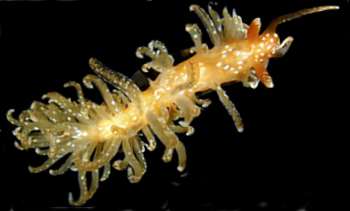
Dear Bill:
Here is another sea slug from Jamaica. As I said in my first message, all specimens were collected from St. Ann's Bay, Jamaica, West Indies. Photo: R. Gundersen.
Is it Spurilla neapolitana? This animal, 2 cm in length, was found in a sterile tide pool.
Best wishes,
Ross
ross.gundersen@uwp.edu
Gundersen, R.W., 2003 (Oct 22) Spurilla neapolitana? from Jamaica. [Message in] Sea Slug Forum. Australian Museum, Sydney. Available from http://www.seaslugforum.net/find/11135Thanks Ross,
This looks very like the animal from Japan which has been identified as Spurilla chromosoma [see message]
As I have mentioned before this Caribbean 'form' differs from Mediterranean animals in which there is clear sign of the digestive gland branching throughout the body wall. Also there is a similar animal with tuberculate rhinophores also found in the Caribbbean. See your earlier message
Best wishes
Bill Rudman
Spurilla neapolitana from the Bahamas
October 22, 2003
From: Colin Redfern
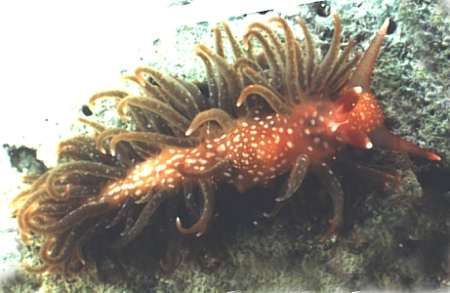
Dear Bill,
I haven't yet recorded this species from Abaco, but attached is a photo of an example of Spurilla neapolitana that was collected and photographed by Jack Worsfold in June, 1983. It was living under a rock at the low tide line on Grand Bahama Island, Bahamas.
Best wishes,
Colin
bahamianseashells@att.net
Redfern, C., 2003 (Oct 22) Spurilla neapolitana from the Bahamas. [Message in] Sea Slug Forum. Australian Museum, Sydney. Available from http://www.seaslugforum.net/find/11310Dear Colin,
This certainly matches the animal in Ross Gundersen's message which I discuss may or may not be Spurilla neapolitana
Best wishes
Bill Rudman
Spurilla neapolitana from Portugal
August 21, 2003
From: Joao Pedro Tojal Loia Soares Silva
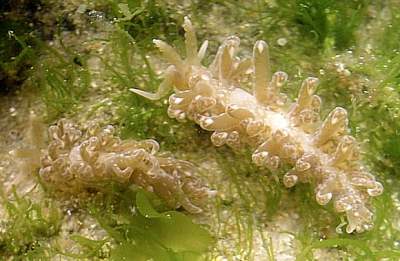
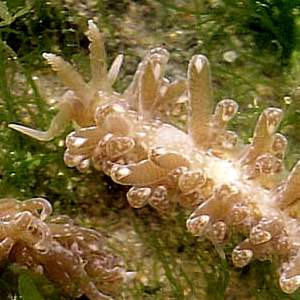
Dear Bill,
Last week I found these two nudibranchs under a rock in the low tide in Baleal, Portugal. The smaller on was approx. 1cm long. Any hint on what these may be?
All the best,
Joao Pedro
jpsilva@uwphotographer.net
Silva, J.P., 2003 (Aug 21) Spurilla neapolitana from Portugal. [Message in] Sea Slug Forum. Australian Museum, Sydney. Available from http://www.seaslugforum.net/find/10782Dear Joao Pedro,
This is Spurilla neapolitana. Have a look at some of the other messages on this page to get some information on its interesting natural history.
Best wishes,
Bill Rudman
Re: Pruvotfolia pselliotes? from Dakar [2]
August 12, 2003
From: Juan Lucas Cervera
Dear Bill and Marina,
I think also this small aeolid is a juvenile of Spurilla.
Cheers.
Lucas.
lucas.cervera@uca.es
Cervera, J.L., 2003 (Aug 12) Re: Pruvotfolia pselliotes? from Dakar [2]. [Message in] Sea Slug Forum. Australian Museum, Sydney. Available from http://www.seaslugforum.net/find/10719Thanks Lucas,
Bill Rudman
Pruvotfolia pselliotes? from Dakar [2]
August 9, 2003
From: Marina Poddubetskaia
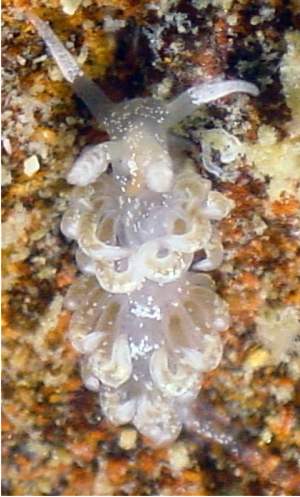
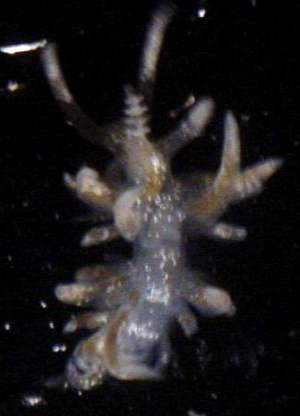
Dear Bill,
Following on from my other message - I think this animal from Dakar is also Pruvotfolia pselliotes. I think this one is juvenile. All of them were found under stones.
Date: June 01, 2003
Location: Senegal, Eastern Atlantic
Site: M'bao
Depth: 6m
Size: 5-6mm
Photos: Marina Poddubetskaia - Nembro website
Best wishes,
Marina.
nembro@nembro.info
Poddubetskaia, M., 2003 (Aug 9) Pruvotfolia pselliotes? from Dakar [2]. [Message in] Sea Slug Forum. Australian Museum, Sydney. Available from http://www.seaslugforum.net/find/10696Dear Marina,
I am pretty sure this is an aeolidiid not a glaucid. If you compare the way the cerata are arranged in this animal with the way they were arranged in your other message, you will see it is quite different. In your earlier photos the cerata were arranged in two major groups, one in front of the heart and one behind it. If you could push some of the cerata aside you would have seen that the cerata were arranged in close, almost vertical rows, 5-7 rows on each side in front of the heart. Behind the heart there are 10 or more rows arranged into 3 or 4 clusters on each side. The clusters are difficult to separate in the living animal. The other distinctive feature in Pruvotfolia is that it is only the innermost cerata in each row which are very long and curled.
In the animal in this message, the cerata are arranged in well-spaced groups. I can't see all the detail but I suspect at least the anterior ones on each side are arranged in an inverted V-shape. Also all the cerata are of similar length. It is therefore most unlikely that this is Pruvotfolia. My feeling is that it is a juvenile Spurilla neapolitana.
Best wishes,
Bill Rudman
Solar powered sea-slug
September 10, 2002
From: Michel Barrabés
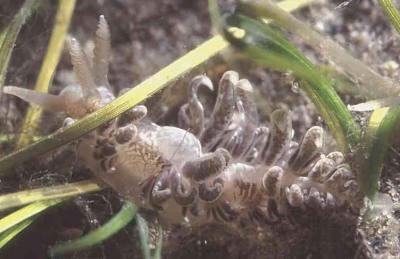
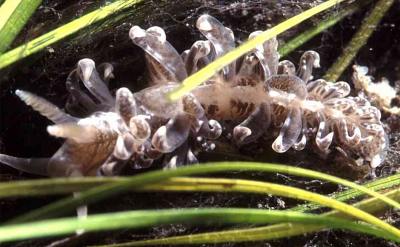
Dear Bill,
On July 25th 2002, I found a slug looking like Spurilla neapolitana at Bassin d'Arcachon, France [Atlantic coast]. It was in a meadow of Zostera nana in the intertidal zone. So it was out of water 6 hours a day ... It had the brown network of symbiotic algae you describe, but it's the first time I seen a Spurilla in such a place. I have found it previously at about 5 to 10 meters, on rocks or sand, but at depth where light is very poor in our green waters. And the previous specimen I found where pink or orange or white, but without the brown network. I have sent photos of this pinkish form in a separate message.
PHOTOS: 7 PM on 25/08/02 about 30 mm long (there were 3 specimen from 10 mm to 30mm with their spawn, similar to that of Spurilla) 0.50 m deep at full tide near "Ile aux oiseaux" in the middle of Bassin d'Arcachon, among a meadow of Zostera nana.
Best regards,
Michel Barrabés
France.
m.barrabes@libertysurf.fr
Barrabés, M., 2002 (Sep 10) Solar powered sea-slug. [Message in] Sea Slug Forum. Australian Museum, Sydney. Available from http://www.seaslugforum.net/find/7886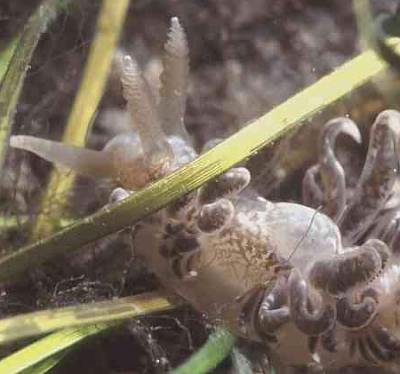
Dear Michel,
Thanks for the interesting photos. Firstly animals in intertidal sea grass beds are largely protected from drying out during low tide by being 'wrapped in' the sea grass leaves which retain considerable amounts of water between the leaves.
Secondly, many of the sea slugs which keep zooxanthellae in their tissues, either have 'forms' which lack zooxanthellae, or go through stages in their life when they lack zooxanthellae. I suspect that those without zooxanthellae are either unable to find zooxanthellae or else are living in an environment in which zooxanthellae cannot survive. As you suggest, poor light at depth may be the reason in this case. Many slugs, including Spurilla obtain their zooxanthellae from the sea anemones they feed on. If the sea anemones that Spurilla is eating lack zooxanthellae then that would explain the pink forms.
What we don't know is how vital the zooxanthellae are for the slug's survival. It is possible that in some species the zooxanthellae are essential, but in most it seems they can survive without them. Whether they can grow to maturity and lay eggs without the nutrition provided by the zooxanthellae is a mystery still to be answered.
Best wishes,
Bill Rudman
Solar powered sea-slug (2)
September 10, 2002
From: Michel Barrabés
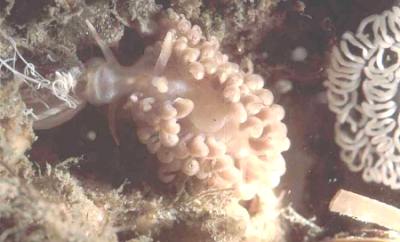
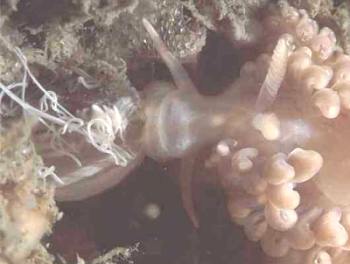
Dear Bill,
Here are the pictures of a pale pinkish Spurilla neapolitana to compare with the ones with a network of ducts containing zooxanthellae, I found in the sea grass beds in the Bassin d'Arcachon, France.
PHOTOS: 21/08/2002 by night, 30 mm long, 8-10 m deep, with its spawn, feeding on sea anemone, (Actinotoe?) at Arcachon city, divesite Saint-Yves on rocks. [Atlantic coast, France].
Best regards
Michel Barrabés
m.barrabes@libertysurf.fr
Barrabés, M., 2002 (Sep 10) Solar powered sea-slug (2). [Message in] Sea Slug Forum. Australian Museum, Sydney. Available from http://www.seaslugforum.net/find/7916Dear Michel,
As I discussed in your other message, this certainly looks like a form of Spurilla neapolitana without zooxanthellae. And from the colour of the anemone it is feeding on it also seems to lack zooxanthellae as well. I guess the tangle of white threads on the anemone are some of the protective acontiae [stinging threads] that some anemones shoot out when they are attacked.
Best wishes,
Bill Rudman
Articles about Spurilla neapolitana
May 31, 2002
From: Daniel Pimpão
Dear friends,
I'm a student from the South of Brazil and I became very interested in having some scientific paper/article about this beatiful nudibranch Spurilla neapolitana. Could you help me? Where could I find that? Thanks.
PS: The pictures in the site are very nice!
Daniel Pimpão
danielpimpao@globalite.com.br
Pimpão, D., 2002 (May 31) Articles about Spurilla neapolitana. [Message in] Sea Slug Forum. Australian Museum, Sydney. Available from http://www.seaslugforum.net/find/7102Dear Daniel,
The most recent and comprehensive revision would be Garcia-Gomez & Cervera, 1985. It is in Spanish but I guess that wouldn't be a problem for you. I have also listed a couple of Marcus which will give you information on some of the west Atlantic records of the species. If you have photos and information on Brazilian animals they would be very welcome
• Garcia-Gomez, J.C. & Cervera, J.L. (1985) Revision de Spurilla neapolitana Delle Chiaje, 1823 (Mollusca; Nudibranchiata). Journal of Molluscan Studies, 51: 138-156.
• Marcus, Er. (1955). Opisthobranchia from Brazil. Boletim de la Faculdade de Filosofia Ciencias e Letras du Universidade de Sao Paulo. Zoologia, 20: 89-262.
• Marcus, E. & Marcus, E. (1977) An annotated Checklist of the western Atlantic warm water opisthobranchs. Journal of Molluscan Studies, Supplement 4: 1-22.
Best wishes,
Bill Rudman
Spurilla chromosoma from Colombia
September 26, 2001
From: Elianny Dominguez
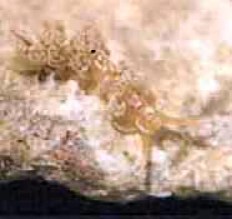
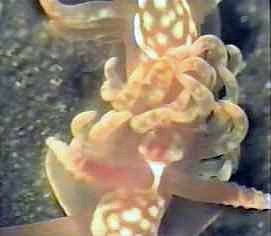
Dear Bill,
I read on your comment that the only real difference you could figure out between Spurilla chromosoma and S. neapolitana was the anterior ceratal cluster having 4 rows or a single arch. In an earlier message Phanor sent you the animal we found on rocky substratum ID as S. neapolitana (October 29, 2000); but now we found two animals of the genus Spurilla and they are quite different.
I'm sending you the photos to see if this could be S. chromosoma. Also I did found this animal back in my country, so I`ll send you those pictures as well on a different message.
Kind regards,
Elianny Dominguez.
elicelotte@latinmail.com
Dominguez, E. , 2001 (Sep 26) Spurilla chromosoma from Colombia. [Message in] Sea Slug Forum. Australian Museum, Sydney. Available from http://www.seaslugforum.net/find/5309Dear Elianny,
I'm sorry but from your photos I think this animal looks the same as Phanor's. I am afraid that without better photos or some anatomical information it is very hard to make a sensible comment on their identity. I am afraid there is just too little information available to me on what these animals look like alive.
Best wishes,
Bill Rudman
Re: Information on Spurilla neapolitana
September 20, 2001
From: Mike Raffa
Bill,
Since no one followed up with your request on where to obtain these aeolids. I would like some info on obtaining some.
Thanks,
Mike Raffa
jerseyreef@home.com
Raffa, M., 2001 (Sep 20) Re: Information on Spurilla neapolitana. [Message in] Sea Slug Forum. Australian Museum, Sydney. Available from http://www.seaslugforum.net/find/5299Dear Mike,
All I can suggest is that you use one of the search engines like www.google.com and search for some aquarium supplier yourself. There is always the problem of not knowing what they are calling it on their site. If you do find any please let us know.
Best wishes,
Bill Rudman
Information on Spurilla neapolitana
January 2, 2001
From: Amar Boubes
Dear Dr. Rudman,
I have a huge infestation of little anemones in my tank by the name of Anemonia cf. majano. I have read in one of the aquarium books that the nudibranch Spurilla neapolitana may be a biological control for this anemone. I am interested in getting your thoughts on this matter.
Thanks for your help,
Amar
aboubes@aol.com
Boubes, A., 2001 (Jan 2) Information on Spurilla neapolitana. [Message in] Sea Slug Forum. Australian Museum, Sydney. Available from http://www.seaslugforum.net/find/3455Dear Amar,
It's possible that Spurilla neapolitana or Berghia verrucicornis could help you with your problem. In fact its possible that most aeolids in the family Aeolidiidae could help because they all feed on sea anemones. However they have their likes and dislikes so I can't guarantee what would happen if you acquired some and put them in your aquarium. There is quite a correspondence in the Forum on using Berghia verrucicornis to control Aiptasia in aquaria. You'll find them on the Berghia verrucicornis Page.
Before you ask where can you buy some - I really don't want to become an agent for buying and selling nudibranchs. I am however happy to include information on where to obtain some of these aeolids, which seem to be able to feed and breed quite happily in aquarium conditions, if someone sends it in to the Forum.
Best wishes,
Bill Rudman
Spurilla neapolitana from Colombia
October 29, 2000
From: Phanor Montoya
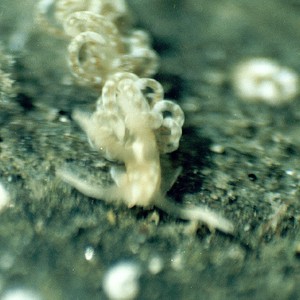
Dear Bill:
This animal was collected from Santa Marta, Colombia. We found it under rocks in shallow waters [<3m (10ft)]. The body is creamy white. The ceras are curved and translucent white, with yellow-brown dots or stains inside the ceras. Eight pairs of groups of cerata. The rhinophores have rings. The tip of the foot is sharp. 9-10mm long.
I think this animal is Spurilla neapolitana, what do you think?
Sorry again for such bad photos.
Phanor Montoya
phamont@eudoramail.com
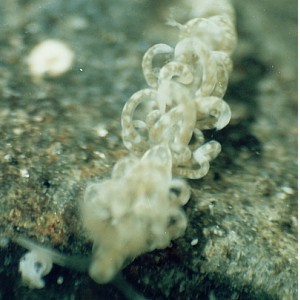
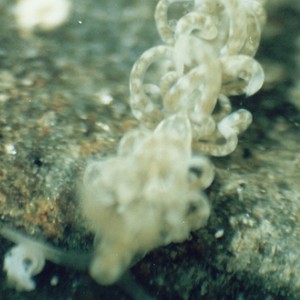
Dear Phanor,
I'm pretty sure you are correct in identifying this as Spurilla neapolitana.
Best wishes,
Bill Rudman.
About red aeolid from Brazil
April 16, 2000
From: Carlo Magenta-da-Cunha
Dear Bill,
I don't believe that the red aeolid is Spurilla neapolitana. I think it is a new species, as it was 100 mm long and was mature. I found other specimens of mature Spurilla neapolitana, but only 30 mm long.
The red sea anemones occur all along the Brasilian Coast (8000 km). Why does this red aeolid appear only in a limited area in southeastern Brasil? Even if I find other color pattern in the same area, I can't say that it is caused by a change in feeding? This situation perhaps occurs in other places?
There are still very many questions .... But this Forum is a good place for many answers, at least for me.
Thanks to all friends!
Magenta
carlomagenta@uol.com.br
Magenta-da-Cunha, C., 2000 (Apr 16) About red aeolid from Brazil. [Message in] Sea Slug Forum. Australian Museum, Sydney. Available from http://www.seaslugforum.net/find/2280Dear Magenta,
I'll leave your 'red aeolid' with S. neapolitana at the moment so it's easy to find. When you get a clearer photo we can see if it deserves a separate page.
Best wishes,
Bill Rudman
Spurilla neapolitana from Brazil
April 15, 2000
From: Carlo Magenta-da-Cunha
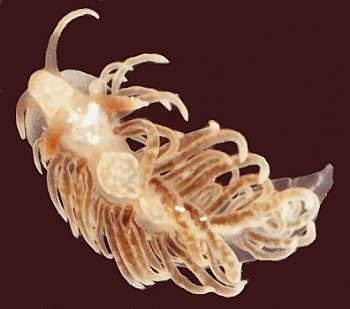
Dear Friend,
Here is a specimen of Spurilla neapolitana from Salvador, Bahia State, Brazil (Coast Northest).
This animal was found by me, under a rock in 0.5 m of water, July 1999. It was 28 mm long.
Best Regards,
Magenta-da-Cunha
carlomagenta@uol.com.br
Magenta-da-Cunha, C., 2000 (Apr 15) Spurilla neapolitana from Brazil. [Message in] Sea Slug Forum. Australian Museum, Sydney. Available from http://www.seaslugforum.net/find/2275Dear Magenta,
It's good to see a nudibranch photo from Brasil. Being familiar with the many scientific papers on Brasilian sea slugs by Eveline & Ernst Marcus it is good at last to see a photo of a living example. I look forward to more in the future.
Have you any thoughts on the red aeolid you sent a photo of some time ago? I suspect it is also S. neapolitana. Perhaps it had been feeding on red sea anemones.
Best wishes,
Bill Rudman.
Re: Parasitic copepods on Spurilla neapolitana
October 20, 1999
From: Constantine Mifsud
I had read somewhere of the name of the particular copepod parasite of Spurilla neapolitana some years ago. I just cannot find the reference. Does anyone know it?
Constantine Mifsud
kejdon@orbit.net.mt
Mifsud, C., 1999 (Oct 20) Re: Parasitic copepods on Spurilla neapolitana. [Message in] Sea Slug Forum. Australian Museum, Sydney. Available from http://www.seaslugforum.net/find/1440Dear Constantine,
I can't help with the copepod's name but I have just noticed that the egg mass of one can be seen in Daniel Geiger's photo at the top of the page.
Bill Rudman.
Parasitic copepods on Spurilla neapolitana
October 16, 1999
From: Erwin Koehler
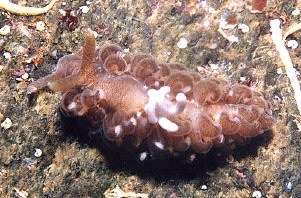
Bill,
Here is one more photo of Spurilla neapolitana, this one with copepod parasitization.
It by Lluís Aguilar, Spain, Portbou, divesite "La Foradada", depth 6 m, size 2 cm. Several specimens were found by turning a rock.
Erwin.
Medslugs.Koehler@t-online.de
Koehler, E., 1999 (Oct 16) Parasitic copepods on Spurilla neapolitana. [Message in] Sea Slug Forum. Australian Museum, Sydney. Available from http://www.seaslugforum.net/find/1428Thanks Erwin,
The white cerata-like objects are in fact the egg masses of the copepod. It has two 'tail-like' egg-sacs at the rear of the body. I presume in this species, the body is embedded in the skin. Have a look at the photo of Phyllidia coelsetis for a free-living commensal copepod.
Bill Rudman.
Spurilla neapolitana from Belize
October 12, 1999
From: Dave Behrens
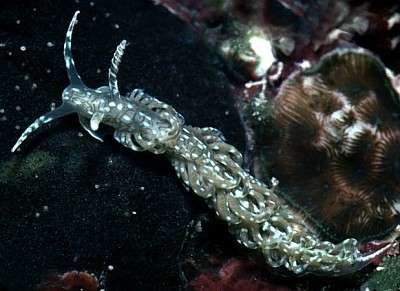
Dear Bill:
With all the terrific coverage of the color variation in Spurilla neapolitana you have recently amassed on the Forum, I thought I'd pull
out a photo I took awhile back in Belize, Central America. This is one of two specimens collected in a shallow, very warm water, mangrove area on Seal Caye, Honduran Barrier Reef, Belize, April, 1992.
My best to you,
David Behrens
Sea Challengers Natural History Books
david@seachallengers.com
Behrens, D., 1999 (Oct 12) Spurilla neapolitana from Belize. [Message in] Sea Slug Forum. Australian Museum, Sydney. Available from http://www.seaslugforum.net/find/1417Dear Dave,
Thanks very much. It's interesting to see the colour variation in some of these wide spread species. It would be interesting to know whether the dark greenish network of lines on the body, in your photo, are digestive gland ducts or a surface pattern on the skin.
Bill Rudman.
Re: Spurilla neapolitana
September 30, 1999
From: Constantine Mifsud
Dear Bill,
In answer to your question; yes I have seen quite a few specimens and they were always the same, Geiger's specimen seems to be of a much darker colour. In my specimens the cerrata are filled with whitish colour pigments while the ones in Geiger's specimen the pigments are brownish. Maybe it is only the type of food taken or the photography.
Constantine
kejdon@orbit.net.mt
Mifsud, C., 1999 (Sep 30) Re: Spurilla neapolitana. [Message in] Sea Slug Forum. Australian Museum, Sydney. Available from http://www.seaslugforum.net/find/1384Thanks Constantine,
Its probable that food is involved. Specimens of Spurilla australis can either have a distinctly visible network of brown ducts in the body wall or there can be no sign of them. However if you examine them carefully under a microscope the ducts are there but either empty. I guess it depends if they are eating anemones with zooxanthellae or anemones without.
Bill Rudman.
Spurilla neapolitana from Hawaii
September 30, 1999
From: Scott Johnson
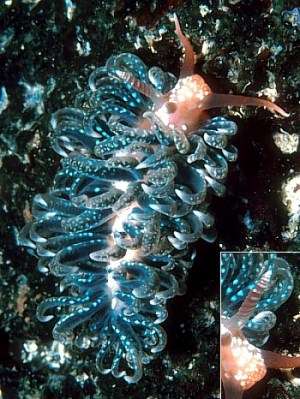
Hi Bill,
Here's a color variation of Spurilla neapolitana from Hawaii.
Scott
johnson@kmr.ll.mit.edu
Johnson, S., 1999 (Sep 30) Spurilla neapolitana from Hawaii. [Message in] Sea Slug Forum. Australian Museum, Sydney. Available from http://www.seaslugforum.net/find/1385Thanks Scott,
This animal certainly gets around. I remember being slightly puzzled when Terry Gosliner reported it from Hawaii some years ago. Apart from the geographic distribution this species seems to have, the colour variation would seem to encompass Carlo's red aeolid from Brazil.
•Gosliner, T. (1979) The systematics of the Aeolidacea (Nudibranchia: Mollusca) of the Hawaiian Islands, with descriptions of two new species. Pacific science, 33(1): 37-77.
Bill Rudman.
Rudman, W.B., 1999 (Sep 30). Comment on Spurilla neapolitana from Hawaii by Scott Johnson. [Message in] Sea Slug Forum. Australian Museum, Sydney. Available from http://www.seaslugforum.net/find/1385Re: Spurilla neapolitana photo
September 29, 1999
From: Constantine Mifsud
Dear Bill
If I remember correctly my photographed specimen from Malta had a parasite or parasite's egg mass on its head.
Constantine
kejdon@orbit.net.mt
Mifsud, C., 1999 (Sep 29) Re: Spurilla neapolitana photo. [Message in] Sea Slug Forum. Australian Museum, Sydney. Available from http://www.seaslugforum.net/find/1376Dear Constantine,
It seems that this species is quite variable in colour as the specimens in your photo and Daniel Geiger's have major differences in colour. His specimen lacks any white patching and has a very prominent dark brown network of digestive gland tissue throughout the body wall. There seems to be no sign of that network in your specimen. Have you seen many specimens of Spurilla neapolitana? If so, is this the normal range of colouration?
Bill Rudman.
Difference between Spurilla and Berghia
September 27, 1999
From: Carlo Magenta
Dear friends,
I would like to know what's the difference between AEOLIDIIDAE and SPURILLIDAE. I would like to know too between Spurilla and Berghia.
Thanks for all.
Best regards,
Carlo Magenta
magenta@goldtec.com.br
Magenta, C., 1999 (Sep 27) Difference between Spurilla and Berghia. [Message in] Sea Slug Forum. Australian Museum, Sydney. Available from http://www.seaslugforum.net/find/1368Dear Carlo,
Have you had any luck identifying you red aeolid or taken further photos of it?
I can answer your first question easily. Most authors consider the AEOLIDIIDAE and SPURILLIDAE to be the same phylogenetic group, and use the name Aeolidiidae.
Your second question is not as simple. The three genera: Berghia Trinchese, 1877, Baeolidia Bergh, 1888, and Spurilla Bergh, 1864, have been subjected to much debate. They all have a very similar arched radular tooth, and have the anterior cerata arranged in arches in Berghia and Spurilla. In Berghia the rhinophore clubs are papillate and in Spurilla they are lamellate (perfoliate) as illustrated here for Spurilla neapolitana. In a review of some Indo-West Pacific species (Rudman, 1982) I proposed that both genera should be synonymised and the earliest name Spurilla be used. I would be surprised if Spurilla neapolitana, with perfoliate rhinophores, and Spurilla australis, with papillate rhinophores were not congeneric. However the third genus,
Baeolidia, is more of a problem, as the type species Baeolidia moebii has never been rediscovered. It is said to have the cerata arranged in rows, and have papillate rhinophores.
There are reproductive differences between the type species Spurilla neapolitana and Berghia coerulescens, and whereas Spurilla neapolitana can harbour zooxanthellae in its body wall (like many Indo-West Pacific species with papillate rhinophores), Berghia coerulescens does not seem to. Perhaps we have been confused by using the rhinophore club as a character. Perhaps both Berghia and Spurilla are distinct genera and both include species with papillate or perfoliate rhinophores.
Terry Gosliner (1980) also discusses the history of these names in some detail.
If anyone can provide some more photos of Berghia coerulescens I would be grateful.
So what do I suggest? I use Spurilla for both Spurilla neapolitana and the Indo-West pacific species with papillate rhinophores, but I realise this is not accepted universally. Basically some more work is needed on this group.
Sorry I can't be more definitive.
Bill Rudman.
•Rudman, W.B. (1982) The taxonomy and biology of further aeolidacean and arminacean nudibranch molluscs with symbiotic zooxanthellae. Zoological Journal of the Linnean Society, 74: 147-196.
•Gosliner, T. (1979) The systematics of the Aeolidacea (Nudibranchia: Mollusca) of the Hawaiian Islands, with descriptions of two new species. Pacific science, 33(1): 37-77.
Spurilla neapolitana
September 27, 1999
From: Bill Rudman
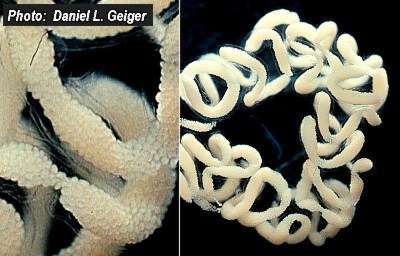
To answer Carlos Magenta's question about Spurilla and Berghia, I have updated the page on Spurilla neapolitana with photos kindly provided by Daniel Geiger. These replace Constantine Midsud's photo from Malta. To accompany those photos from Banyuls sur Mer, on the Mediterranean coast of France, is a photo of the egg-mass.
I am not sure how much variation occurs in this species so I would be grateful for some comment on whether Constantine's photo and Daniel's are of the same species.
Bill Rudman.
Rudman, W.B., 1999 (Sep 27) Spurilla neapolitana. [Message in] Sea Slug Forum. Australian Museum, Sydney. Available from http://www.seaslugforum.net/find/1372Spurilla neapolitana - distribution
June 5, 1999
From: Orso Angulo
Hi Bill
I'm a student of marine biology in La Paz, Baja California Sur (Mexico). Searching in the past messages of the Forum I found that S. neapolitana is only cited for Atlantic, from Brazil to Florida and the Mediterranean. I must tell you that it is also reported for the east Pacific, Basically in Baja. I recommend that anybody who is interested get a view of the work of Skoglund, 1991 in which she makes an update of the literature from 1971 to 1990. It is based on Keen, 1971.
Orso Angulo
mol@lapaz.cromwell.com.mx
Angulo, O., 1999 (Jun 5) Spurilla neapolitana - distribution. [Message in] Sea Slug Forum. Australian Museum, Sydney. Available from http://www.seaslugforum.net/find/920Dear Orso,
Thanks for the information. Could you give me a full reference to Skoglund's review please?
I have hunted down what I presume is the first reference which is;
Bertsch, H. (1979) Tropical Faunal affinities of opisthobranchs from the Panamic province (eastern Pacific). Nautilus, 93(2-3): 57-61.
If you have photos or observations on this nudibranch, or any other Sea Slug from your part of the world I would love to put them on the Forum.
Best wishes,
Bill Rudman.
Here is a Spurilla neapolitana photo
December 11, 1998
From: Erwin Koehler
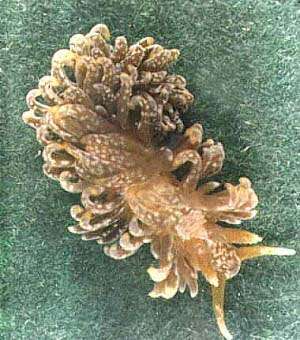
Dear Bill,
Here is a photo taken by Constantine Mifsud, Rabat, Malta. http://www.medslugs.de/E/mssmain.htm
There is another on the same site - a good photo, but not for identification.
Ciao
Erwin Kohler.
E.Koehler@deutschepost.de
Koehler, E., 1998 (Dec 11) Here is a Spurilla neapolitana photo. [Message in] Sea Slug Forum. Australian Museum, Sydney. Available from http://www.seaslugforum.net/find/375Thanks Erwin,
I guess we'll need a better photo from Brazil to be sure if its close. Carlo, perhaps you can remember what the rhinophores look like. In some species they are papillate as in this species and in others smooth or lamellate. or perhaps you have another photo?
Bill Rudman
Spurilla? from Brazil
December 10, 1998
From: Carlo Magenta
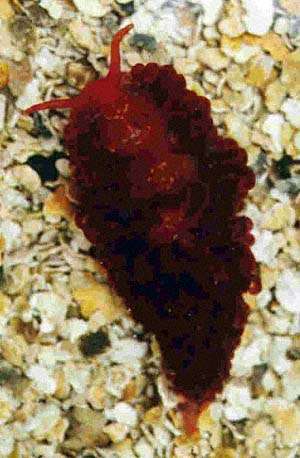
Dear Bill,
What's this? Depth 0,5 - 1 meter; on rock, with much seaweed. I did collect this
specimen 2 month ago.
yours truly,
Carlo Magenta
Sao Paulo
Brasil
magenta@goldtec.com.br
Magenta, C., 1998 (Dec 10) Spurilla? from Brazil. [Message in] Sea Slug Forum. Australian Museum, Sydney. Available from http://www.seaslugforum.net/find/371Dear Carlo,
I am not an expert on the Atlantic fauna so perhaps one of our European or North American friends can help. It looks like a Spurilla or Berghia. Ernst Marcus (1955) describes some specimens from Sao Sebastiao Island, Sao Paulo State which he identifies as Spurilla neapolitana (Chiaje) var braziliana MacFarland, 1909. He describes the colour as "orange with a brown liver. On the back is a pattern of light spots"
Your photo could possibly be of this species which he later (Marcus & Marcus, 1977) considered simply to be a colour form of Spurilla neapolitana.
References:
• Marcus, Er. (1955). Opisthobranchia from Brazil. Boletim de la Faculdade de Filosofia Ciencias e Letras du Universidade de Sao Paulo. Zoologia, 20: 89-262.
• Marcus, E. & Marcus, E. (1977) An annotated Checklist of the western Atlantic warm water opisthobranchs. Journal of Molluscan Studies, Supplement 4: 1-22.
Best wishes,
Bill Rudman.
